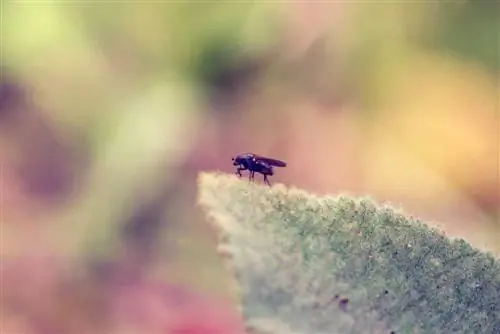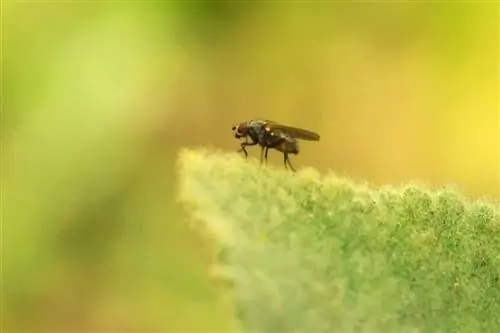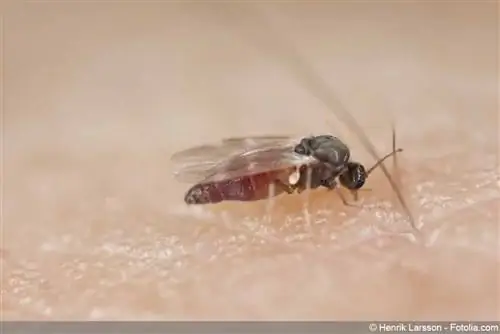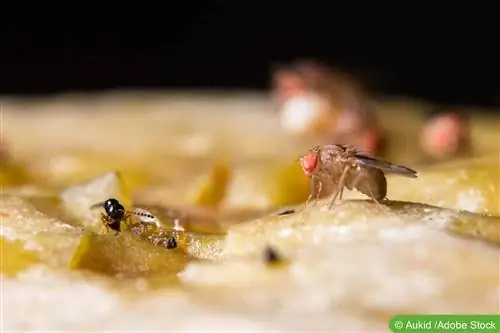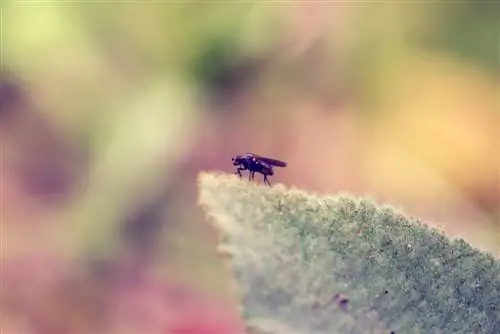- Author admin [email protected].
- Public 2023-12-17 03:39.
- Last modified 2025-06-01 06:48.
Flies are also capable of learning and like to stay warm in winter, and so some species of these insects have discovered human homes in order to “hibernate comfortably”. Not nice for people with houses whose facades are warmed by the sun and are in a natural environment; but it is a nuisance, not a catastrophe with terrible consequences. This nuisance can be kept to a tolerable level through cleaning, a few tricks and preventive measures for the future:
Flying in autumn, winter, spring
The following flies like to nest in the warm interior to overwinter:
Block fly, worm fly, Pollenia rudis
The fly, officially named the “grey-yellow cushion fly”, is called the “cluster fly” in the English-speaking world, precisely because of its habit of appearing in large clusters in (unfinished) attics and similarly rarely used rooms. To comfort the insect, the fly swatter should bathe the room in pleasant smells because crushed “buckwheat flies” smell like “buckwheat honey”. The thick black fly can easily be confused with the normal house fly; But it is not a normal house fly (house fly, Musca domestica), it belongs to the family of “real flies” and is more likely to be found as a single specimen.
The intrusive winter visitor belongs to the family of blowflies, which were named after the Old High German “schmeißen”=to smear, to soil, because they have an unpleasant preference for odorous organic substances. Not the stuff people want in their homes, which is why many people find flies disgusting. This is not absolutely necessary for the normal house fly, the passion of the housefly, which was already described as "sweet-toothed" in Brehm's Animal Life, is sugar in any form, which is not a hygienic disaster, even from foreign fruit.
Even the “cluster flies”, which have a slightly different taste, didn’t smell any corpses in the attic; they are not interested in anything other than hibernation. The flies no longer eat any food in their winter hiding place and they do not reproduce either.
How to recognize the worm fly:
- Just under an inch tall (a little bigger than house flies)
- The golden wings overlap when resting (housefly: wings remain separate)
- Black bristles on the middle of the body, finer golden hairs on the sides
- A pattern of silvery-gray and black spots on the abdomen
- Slow compared to the lightning-fast house flies
You have a good chance of being visited by flies if the sun shines on your house facade for part of the day. When the first night frosts threaten, the flies gather on such warm facades in order to move into their winter quarters from there; through open windows, mini gaps in the facade, through roller shutter boxes or under bricks. And the block flies come back because good experiences are obviously passed on to the next generation - entomologists have investigated that several generations fly to the same winter quarters again and again.
Other species of flies that overwinter indoors
Other potential attic guests are the stable or eye fly Musca autumnalis (which are light in the back and usually not as numerous as the cluster flies) and the stalk fly Thaumatomyia notata (tiny, yellow-black flies with a preference for tall buildings, next to one Church, for example, you are usually spared from visiting).
If the worm flies do not “hibernate” peacefully but frolic around vigorously, it is due to a series of warm, sunny autumn-winter days, or you have turned on the heating, or it is slowly coming to spring and the flies are waking up from it Hibernation. The flies then become active and orient themselves towards the light. If it comes from outside in spring, you can get rid of the flies by opening the window or roof hatch.
Dealing with the plague of flies
Honestly, with unfinished, unused attics, the easiest way is to just let the flies overwinter and wait until they have fledged in the spring. You can then include the attic in your spring cleaning, “armed” with a really good vacuum cleaner (can be rented from the nearest hardware store). This means you can quickly remove any fly residue, even in cracks and nooks and crannies, and after wiping it with a hygiene cleaner, your attic will shine as if no fly had ever found its way there.
Tip:
A new winter guest is the Asian lady beetle Harmonia axyridis, which does not experience winter cold in its homeland and therefore moves into suitable winter quarters in large swarms in October/November. Not just in attics, in the USA they appear in living spaces so regularly that they have been nicknamed the “Halloween ladybird”. In terms of locking them out, removing them and fighting them, they are treated like flies, but there is an even better reason to leave them alone if possible: When the ladybugs panic, they react with so-called reflex bleeding, in which they emit bitter and foul-smelling Spray liquids - even into inaccessible roof intermediate layers.

Just letting flies overwinter in the attic isn't possible because flies bring dangerous germs into the house? That's right, flies pick up germs with their trunks and feet when they search for food; If you live next to a hospital for rare tropical diseases, these germs could be dangerous. Just kidding, normal flies of course only bring normal germs from the environment - and these are germs that are buzzing in the air around you all day anyway; in addition to the more than ten thousand different species of bacteria that live on and in humans as a microbiome. If the flies in your attic don't have to fight their way through puddles, these germs - like all life that rely on moisture - are either dead or encapsulated in non-infectious permanent forms after a few hours. If you realize that in terms of infection the nearest supermarket and the next subway are a hundred times more dangerous than flies, the flies in the attic become a lot more harmless.
Unfortunately, the flies only remain inactive in their winter quarters when the winter temperatures remain low. Bright winter sun wakes up the flies in the middle of winter, light and heat radiate from the lower part of the house through the attic entrance, or the flies have immediately "entered" an adjoining room that is heated in winter anyway. If the flies become active somewhere near you or make their way from the attic towards the living room, you of course have to take action, you have the following options:
- Flies that have just entered the house can be tackled with any fly trap you can grab
- If you don't want to kill flies because of the dramatic decline in insect numbers, use biological fly traps that are emptied outdoors: jars with leftover fruit and a perforated foil cover
- With their sluggishness and habit of gathering in clusters, worm flies are an invitation for a sporty quarter-hour with the fly swatter
- If the windows/roof hatches are open, a large proportion of the winter guests will escape into the open in the face of the violent attack
- If early control failed because the “influx” was not noticed in time, the attic should be visited occasionally with the vacuum cleaner
- Because some of the flies usually die in their winter quarters (the drier the rooms are, the sooner)
- Dead flies that are not removed attract pests that only really come into play when carrion is found in the attic
Combat
Even the “panic press” hardly dares to call for “fighting flies,” but there are situations in which flies overwintering in the attic cannot be tolerated. For example, when your own harvest is drying there:
- The entrances can be secured with anti-insect adhesive strips (contain contact poison + attractant)
- Overwintering flies can be destroyed with UV insect traps
- They catch most flies at a maximum height of 1.5 m
- The traps should not be visible from the outside, competitive lighting should be avoided
- They work best in really dark environments
- But needs regular maintenance: Depending on the version, empty the drip tray, clean it or replace the adhesive film
Tip:
There is no good advice in sight when buying UV insect traps: Stiftung Warentest has not yet examined the products; The numerous comparison portals that now clog the Internet write a lot and at length, but with little meaningful content. A few of the best quotes from test placements: "resembles an air freshener, which makes the product attractive to buy" (Huh?), previous customers report success in catching insects (good thing future customers don't report), for flies and An ideal trap for mosquitoes of usual size (if it doesn't work, were the insects of an unusual size?). Only electricians should trust (sensible) instructions for building UV traps yourself, but even they will need a considerable amount of time to find sources of supply for the very special adhesive films. The quickest way to get a usable device is probably to ask the nearest bakery about the device you are using (of course only if it visibly works well).
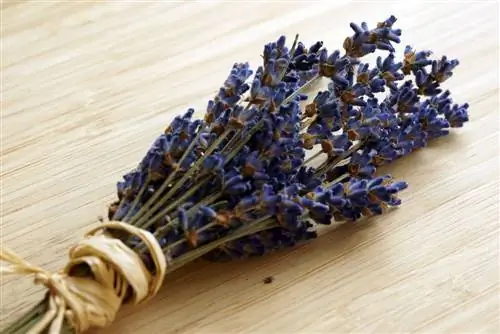
If it's more about "a few bouquets of herbs" that are hardly worth the effort, the following measures are conceivable:
- If the dry goods have been hanging for a while, finish drying them in the oven at 40 °C and pack them up
- Wrap medium-sized quantities loosely with thin paper bags to prevent “crumbs”
- Finish drying in a room where the flies have not yet discovered
- and leave a sacrificial bouquet hanging in the attic for the flies before you attack them with traps or simply let them overwinter
Preventive measures
there are theoretically, first of all the normal measures that are part of life for many people in the summer so that they don't “get lost in flies” should be mentioned here. This refers to people who live in the countryside, maintain natural gardens with a variety of plant species, have a stable or flower meadows or forests next to them, and the measures look like this:
- Fly screens, used here in winter and in front of all openings in the attic
- Targeted use of scents, various essential oils can repel flies
- Scented lamps in the attic need to be refilled occasionally
- Experience shows that most flies avoid lavender, peppermint and eucalyptus
- Ventilate frequently in autumn, flies are very sensitive to drafts
- Don't leave food lying around openly anywhere during critical times, especially not near the attic
- Essential oils etc. can be sprayed on the outside of the facade
- On light-colored facades, be sure to test for any discoloration well in advance
- You can support this defense with anti-fly plants such as lavender at the bottom of the facade
- Combined with an insect hotel at the back of the garden, this can even keep “traditional guests” away
- Repair + maintenance of all windows, doors, hatches, roofs that are in good condition to better keep insects out
- Simple cleaning always helps when flies often appear in certain places
- Trash cans should be tightly closed and emptied more often
- When there is an increased number of flies, automatic door closing devices reduce the entry of flies
However, you should not let anyone convince you of the idea that you can make a house “insect-proof” (with particularly innovative, particularly expensive fly screens, etc.). Older houses don't, but even in a new building you won't always be able to exclude all uninvited guests over the winter.
There are around 1.5 billion insects for every person on earth (not an estimate, there are actually smart/crazy people who calculate something like that); Human/insect encounters are therefore “not entirely unlikely”.

But it's very similar to burglars: If your living room table, which weighs tons, is made of solid gold and is visible to everyone (flies “sniff out” an abundance of uncovered food (leftovers) on the kitchen table and worktops), a greedy burglar will emerge (a greedy insect) gain entry no matter how you secure your home. If in your house you can only get what experience has shown you can get in such houses, but access/approach is not that easy at first glance, burglars/insects prefer to move on to the next house.
Be careful when using insecticides
You can use insecticides in many places around the “overwintering guests”:
- It is sometimes advised to spray the facade with long-acting contact insecticides
- Fly windows or gauze can also be thoroughly “treated with insecticides”
- As well as the attic entrances towards the living area including the nets, curtains, seals in front of them
- But “long-term effect” is relative, and flying in for overwintering is not tied to an exact date
- Experience has shown that the use of insecticides is therefore rather low in effectiveness
The use of insecticides should also be carefully considered; because it has a number of disadvantages for the user:
- The products are not only toxic to insects, Raid e.g. B. contains DEET, de.wikipedia.org/wiki/Raid_(insect spray), other agents pyrethroids, de.wikipedia.org/wiki/Pyrethroid
- Many of the remedies “stink to high heaven”, and unfortunately also strongly downward towards garden users
- Flies in the attic can die in large numbers in inaccessible places
- Dead flies attract more pests
- Inappropriate, excessive use of insecticides has already made many insect species resistant
- Every use of insecticide creates further resistance
- Avoidable missions contribute to the fact that at some point there will no longer be any funds available for really critical cases
Tip:
Stay away from electrical devices that claim to kill flies and mosquitoes outside buildings. Firstly, it's not true, mosquitoes only stray onto the grill plates in single-digit percentages, and the flies you want to keep away, at least as repeat offenders, don't at all, they know their destination. Secondly, many beneficial insects are stewed alive, not such a nice death by the way. And thirdly, the use of all of these devices outdoors is prohibited because so many useful insects are stewed alive - which we humans need, here is NABU's call against these devices: www.nabu.de/animals-and-plants/artenschutz/legal-basis/fazit.html.
Special situations and measures
If you have pets that are fed near the fly shelter, you should either pass this food somewhere else in the spring or put it away immediately after eating. When the first warming sun shines and wakes up the overwintered flies, all they want to do is get rid of their eggs in order to ensure the continued existence of the species, for example cat food. B. is ideal for this (of course applies to any type of food or food supply).
If your roof has just been re-roofed or insulated, a sudden “fly infestation” can be a sign that the work was not carried out quite as it should. In this case, check the entire layer structure together with a qualified person. There is also a roof truss that has not been converted for living, which has been freshly renovated, for example. B. insulated with aluminum-clad glass wool insulation + vapor barrier foil will not be so tight that no insects can ever get through, but mass immigration should be prevented by such an insulation layer. Such a density is especially necessary if the attic has been converted into a living space with a thicker layer of insulation. Where a lot of flies come in, a lot of heat comes out, and this usually needs to be improved.

